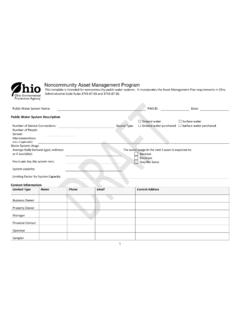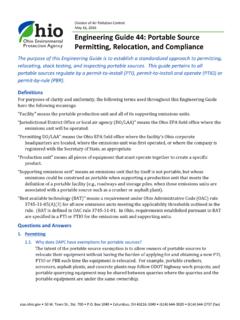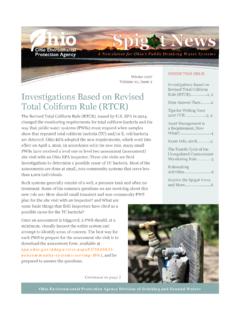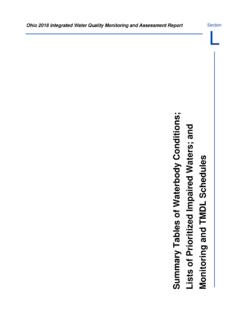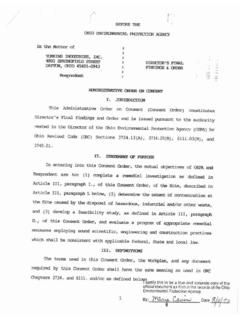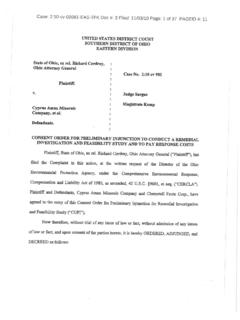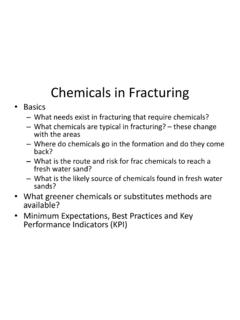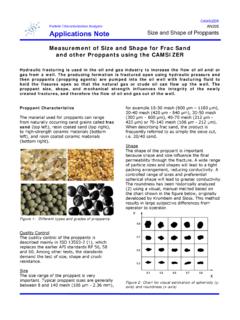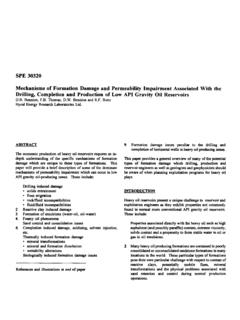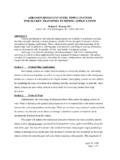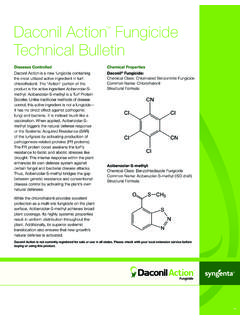Transcription of Subject: Landfill acceptance and disposal of waste ...
1 November 17, 2014. subject : Landfill acceptance and disposal of waste substances from horizontal wells - update Dear Facility Operator: As oil and gas drilling activity in the Utica/Point Pleasant and Marcellus Shale formations continues to develop, licensed municipal solid waste landfills in Ohio and surrounding states should expect to see increased volumes of incoming waste substances generated from the drilling process, including drill cuttings, tank bottoms, and used frac sands. In addition, Landfill operators may see increased volumes of filter media, including filter socks from processing and treatment activities of fluids at waste substance facilities 1, or from underground injection control wells used for the disposal of brine. House Bill 59 strengthened Ohio laws administered by the Ohio Department of Natural Resources (ODNR), Ohio Department of Health (ODH), and Ohio Environmental Protection Agency (Ohio EPA) that ensure oil and gas waste substances are properly managed and disposed.
2 Our agencies wanted to take an opportunity to highlight some important impacts to Ohio landfills resulting from House Bill 59 and shale development. Stabilization of waste Substances Since January 1, 2014, ODNR regulates the storage, recycling, treatment ( stabilization), and processing of waste substances associated with a horizontal well 2, and Ohio law provides for the disposal of waste substances other than brine at Ohio solid waste landfills. Due to the liquid content in waste substances, these materials may require stabilization or other processing prior to Landfill disposal . Generally, waste substances passing the paint-filter test are solid wastes regulated by Ohio EPA when disposed in accordance with ORC Chapter 3734; however, waste substances also include materials that do not pass the paint-filter test or do not meet the definition of solid waste . 1. Section (B)(2)(a) states, in part, that No person shall store, recycle, treat, process, or dispose of in this state brine or other waste substances associated with the exploration, development, well stimulation, production operations, or plugging of oil and gas resources without an order or permit issued under this section or section or of the Revised Code.
3 Landfill acceptance of waste that contains brine and requires stabilization is prohibited, unless authorization is obtained pursuant to ORC Section 2. See ORC Section (B)(2)(a). Landfill acceptance and disposal of waste substances from horizontal wells - update Page 2. Drill Cuttings Designation as Solid waste Drill cuttings generated during the phase of drilling performed through underground source(s) of drinking water (USDW), prior to the cementation of surface casing, are considered earthen material and are not regulated as a solid waste by Ohio EPA. This phase of well construction is drilled with air, fresh water, a freshwater based drilling fluid, or a combination thereof because only additives suitable for drilling through potable water supplies may be used while drilling these intervals. Even though these drill cuttings are not regulated as a solid waste by Ohio EPA, they are a waste substance regulated by ODNR. Drill cuttings generated below the surface casing are classified as a solid waste and must be sent to a licensed solid waste Landfill or otherwise managed in accordance with applicable law.
4 Drill cuttings classified as a solid waste are subject to state and local disposal and generation fees. If a solid waste Landfill accepts drill cuttings that are earthen material and not a solid waste , it is recommended that Landfill operators request written documentation from its customers that affirms the information listed in the table below. This documentation should be maintained in the facility daily log. Criteria for Determining When Drill Cuttings are Earthen Material or Solid waste (ORC Chapter 3734). Earthen Material Solid waste Drill cuttings generated during Drill cuttings generated below drilling through USDW (drilled on surface casing air, fresh water, and fresh water- Drill cuttings containing additives based drilling fluid) not suitable for drilling through Drill cuttings containing only potable water supplies, including additives suitable for drilling but not limited to refined-oil based through potable water supplies substances or other contaminants Drill cuttings stabilized with solid wastes or non-earthen reagents Drill cuttings mixed with solid wastes waste Substances Designation as NORM.
5 Landfill owners and operators should be aware of the radioactive content of drilling- related waste substances accepted for disposal . Drill cuttings, whether an earthen material or a solid waste , are defined as naturally occurring radioactive material (NORM) when mechanically processed to remove drilling fluids in order to pass the paint-filter test . Landfill acceptance of solid waste classified as NORM is not subject to the analytical results provision of ORC Section (Q). Landfill acceptance and disposal of waste substances from horizontal wells - update Page 3. Since September 29, 2013, Ohio Landfill owners and operators are required to obtain representative analytical results for drilling-related waste substances defined as technologically enhanced naturally occurring radioactive material (TENORM). ODH. published a document titled NORM/TENORM Information Sheet, which summarizes the applicability of NORM and TENORM to drilling-related waste substances.
6 The table below summarizes common waste substances that are sent to solid waste landfills for disposal . Summary of NORM/TENORM waste Substances Resulting from Oil & Gas Exploration & Production NORM TENORM. Drill cuttings - pass the paint-filter waste Substances that contain test (drilling fluids removed by used drilling fluids and pass the shakers, presses, centrifuges, and paint-filter test , and may have other processes) previously been stabilized with Portland cement, quick lime, or other ODNR DOGRM approved stabilization agents Used refined oil-based muds Used frac sands Tank bottoms Pipe scale Used filter media, including filter socks from underground injection control wells Representative Sampling and Analysis of TENORM. Ohio Law (ORC (Q)) requires Landfill owners and operators to obtain representative analytic results for TENORM associated with horizontal wells prior to acceptance at the facility. To provide compliance assistance on sampling and analysis methods, ODH Bureau of Radiation Protection (BRP) developed guidance 3.
7 When accepting TENORM from horizontal wells for disposal , it is ODH BRP's recommendation that facility personnel who approve special wastes discuss these 3. ODH has published the following guidance regarding the representative sampling and analysis of TENORM . Acceptable TENORM Analytical Methods for Radium-226 and Radium-228. ~/media/ODH/ASSETS/Files/rp/technical%20 support/ Guidance for Sampling waste Containing TENORM. ~/media/ODH/ASSETS/Files/rp/radiation%20 protection/2013/2014/Sampling%20P. rotocols%20 Document%

